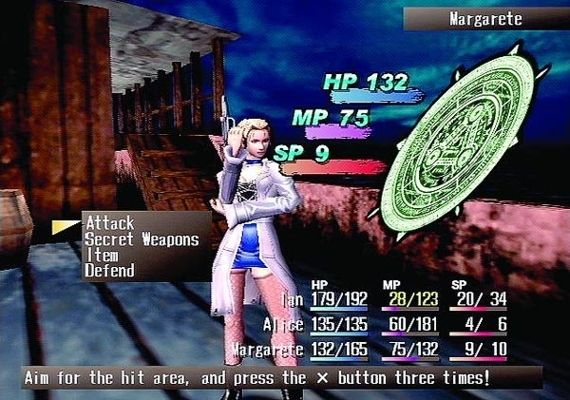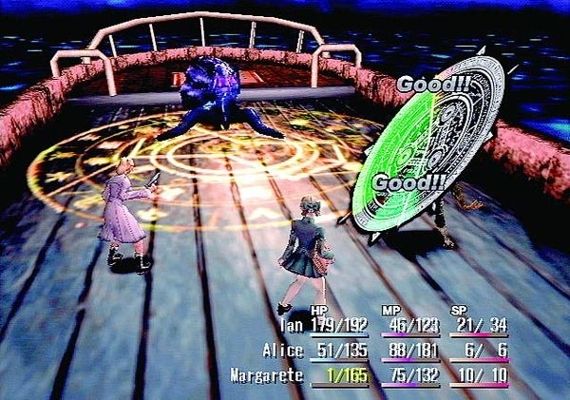[Off the grid is a weekly column focusing on titles that may have flown under many people's radar at the time of release, for whatever reason. Usually the titles have some redeeming quality and weren't just overlooked because they were horrible games.]
Shadow Hearts (developed by Sacnoth, published by Midway in the U.S.) had possibly one of the most unfortunate release dates of the PS2 generation - it came out just one week prior to Final Fantasy X. Not only was there a new Final Fantasy title, but it was the first one on the PS2. For this reason alone, I think Shadow Hearts was completely overlooked around it's release, and only later found a cult following. I know I didn't play it until a couple years later when I was looking for new and interesting RPGs to pass the time. But, I'm sure glad I picked it up and played it, because it is a rather unique and compelling title - something you don't see often in the JRPG genre.
At its heart, Shadow Hearts is built on a standard turn-based RPG system. Nothing new there, right? That being said, there are two main things that made this game stand out for me: 1) its setting and 2) the Judgment Ring system. Let's chat a little about both.
Shadow Hearts is set in an alternate pre-World War I Earth - the year 1913, to be exact. There are many real-world locations that serve as the stage for the major plot points throughout the story, including the Trans-Siberian Railroad, Shanghai, London and Prague. While you do see other RPGs set in the "real world", or at least Earth in general, most of them don't focus on actual locations and specific time periods like we have here. This lends itself to the uniqueness of the title and helps enhance the visual look and feel of the graphical presentation - all that together making the Europe and China at the beginning of the 20th century feel familiar, yet alien at the same time.
In addition to the setting, the story itself was also rather unique. It follows Yuri and his quest to save a woman, Alice (she's hot, who wouldn't want to save her?). The quest takes them through Asia and then Europe, all the while looking for clues as to why Alice is of such importance. Along the way, naturally, they make friends and enemies - including some people who actually lived (Margarete Gertrude Zelle and Roger Bacon). So, in a way, some bits and pieces of historical fiction come into play throughout the story and amongst the characters, as well. To offset that, there are vampires, demons and mystical creatures of all sorts, as well as evil warlocks wanting to summon unimaginable power to destroy entire cities. Shadow Hearts succeeds at weaving a tangled web of mystery and intrigue right up to its conclusion. It's still one of the most gratifying, unpredictable and thematically intense JRPGs I've played to date.
Setting, story and characters aside, the game play did include many RPG staples. But, in addition to those, the Judgment Ring mechanic was introduced. This is a game play mechanic that permeates all aspects of the game, not just battle. The Judgment Ring is a ring (duh) with different colored areas and a needle that rotated around and stopped when the player told it to. You can choose various actions that would involve the Judgment Ring. The main segment used in battle situations is the "Hit Area" - which is a different color depending on what action you're attempting to perform. If you stopped the needle in the "Hit Area", you performed the action successfully to its fullest potential. The "Hit Area" is surrounded by very thin slices of red which is a "Critical Area" - if your needle lands here, you get extra damage or a more potent effect from the item you're using. There are various incarnations of the ring for various different abilities, items, special moves and what not. There are also Judgment Rings for mini-games, buying items at stores and other non-combat aspects of the game.
This all added an extra layer of depth to the combat and game play in general, which was rather unique and strangely fulfilling. Sure, it took some getting used to, and it certainly wasn't as timing-based as The Legend of Dragooon's Addition mechanic, for example, but it was a nice perk to spice up the standard turn-based RPG formula a bit.
Shadow Hearts is a game full of unique features; it's quite a shame that many people still haven't played this game because of its niche nature. If you have a PS2 and find it in a bargain bin somewhere, I highly advise trying it out. Also, the follow-up - Shadow Hearts: Covenant - is pretty amazing, as well. It enhances and builds upon the style of the first title and continues Yuri's story. Both games are worthy of your time if you feel like checking them out. [For the record, don't bother with Shadow Hearts: From the New World - it doesn't stick with the same look and feel that make the first two Shadow Hearts games so great and revolves around completely different characters.]
Anyone else out there enjoy the Shadow Hearts titles? Think there should be a current generation Shadow Hearts?


